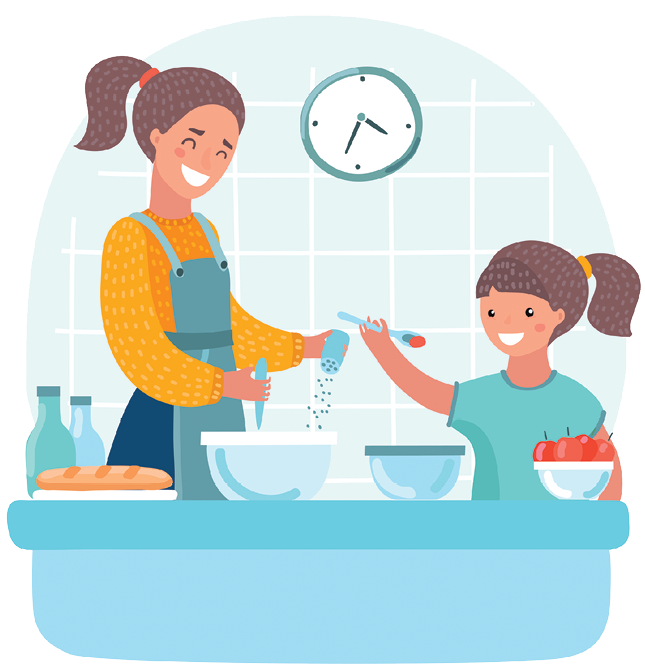
Kids in the Kitchen
Ingredients for Success: Inspire a love of cooking in your kids with these creative tips
By Sarah Lyons
These days, many of us are spending more time in the kitchen. It’s also an ideal time to teach kids a valuable skill that will stay with them for the rest of their lives: cooking. The good news? Kids that are comfortable in the kitchen are usually more self-sufficient, eat healthier foods, have a wider palette, and are more open to trying new foods. More importantly, cooking with kids can be fun and enjoyable for both the children and adults – and create some of the fondest memories.
Cooking Tasks at Every Age
Here are some suggestions to help get your kids – from toddler to teen – excited about the kitchen:
AGES: 8 MONTHS–2 YEARS
For the little ones, consider incorporating baby-friendly kitchen utensils into playtime. Try modeling common cooking activities – for example, use a wooden spoon and plastic bowl and pretend to stir ingredients. While at the store or unloading groceries, identify the names and colors of foods.
AGES: 2-5 YEARS
Preschoolers can be great little helpers on simple tasks. They can help wash fruits and vegetables in the sink, tear lettuce for salad, measure dry/wet ingredients, knead dough, stir muffin or pancake batters, decorate cookies, and add toppings to a pizza. Taste foods together and discuss textures and flavors.
AGES: 6-9 YEARS
Help your child read and follow simple recipes; slice or cut food with a butter knife; measure and assemble prepared ingredients; and operate a toaster, microwave and can opener. Discuss kitchen math, proper sanitary practices, and how to plan a meal for the whole family, by having them follow an easy recipe or help come up with a grocery list. Some recipes to try: smoothies, yogurt parfaits, trail mix, guacamole, quesadillas, tortilla wraps and green salads with dressing.
AGES: 10-12 YEARS
Kids can be responsible for preparing portions of a meal; selecting recipes and making a grocery list; safely handling raw meat, poultry and fish; and baking in the oven. Talk about how to plan meals and avoid cross-contamination. Some recipes to try: pasta and tomato sauce, chili, tacos, meatballs, turkey meatloaf, omelets, muffins, cupcakes and cookies. Kids that can follow kitchen safety rules may be able to tackle more complicated recipes.
Here are six creative ways to get your kids cooking:
Build your own.
Give kids the opportunity to make their own choices. Try having a taco or potato bar for dinner and offer a variety of toppings where kids build their own meal. This works especially well for toddlers who are not quite old enough to do a lot of cooking but still want to help in the kitchen. Other ideas may be building your own pizza, and making your own omelets or pancakes. These meals give kids the opportunity to sample fruit or vegetables they may not otherwise try, and use a little creativity as well.
Grow your own.
What better way to get kids to understand the process involved in growing and harvesting food than to plant a garden in your own backyard. Allow the kids to use their creativity to decide what foods your family would like to grow, plant them, care for them, and harvest them. You may need to make a trip to a local nursery to get a good idea of what will grow in your climate. Once they harvest their crop they can help plan meals where they’ll use the produce they’ve grown and sample it themselves. This is a great way to get kids to try vegetables. If you are short on yard space, look into container gardening for things that you can grow on decks or patios.
A science experiment.
Cooking is a great way to teach kids about science. Baking ingredients need to be measured exactly for the recipe to come out as expected, where soups, casseroles, salads and other savory dishes are more forgiving when the ingredients are adjusted slightly. Allow kids to get creative with ingredients. Does this dish need more salt? More onion? More cheese? Older kids, with supervision, can be given the opportunity to experiment with tastes and ingredients and express their creativity. You also can teach kids about science by explaining what would happen if you forgot a baking ingredient like flour, baking powder or salt.
Creative presentation.
Kids who are particularly fond of visual art may enjoy creating an aesthetically pleasing dining experience even more than cooking. Kids can express their creativity in the kitchen without even using their cooking skills. Setting the table, creating a centerpiece, or arranging food on a plate so that it looks as good as it tastes are all good creative tasks for kids.
Make it a competition.
Most kids enjoy a friendly competition and many also like watching cooking competitions on reality TV. You can bring this idea into your home kitchen by creating your own cooking competition. Pick a theme and let the kids get creative by making their own recipe. Some ideas might be a cupcake or cookie decorating challenge, an appetizer, or main dish. You can make it more challenging by determining ingredients they must include (or can’t use) in their recipe.
Plan the menu.
My kids don’t always love what I cook on weeknights. To get them involved and increase the likelihood that they will eat what I am serving, I like to ask them to help me plan the weekly menu. Sometimes my older kids will offer to cook one of the meals themselves. I try to encourage them to choose menu items that include vegetables and fresh, healthy ingredients. This also gives us an opportunity to discuss budget. You can take it a step further and let them help you shop for items at the store and then help prepare the meals.
Kid-friendly recipes
Need some recipes for your budding chef? Here are some of our favorite kid-friendly recipes (that also double as fun family activities!):
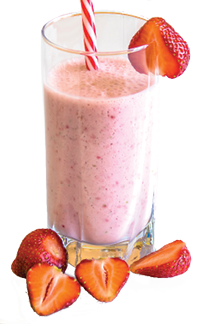
Berry banana smoothie
• 1 cup frozen mixed berries
• 1 frozen ripe banana
• 1/2 cup low-fat vanilla yogurt
• 1 cup milk, or dairy-free alternative
• 1-2 Tbs honey, optional
Note: if using fresh fruit, add ice
Add all ingredients into the blender and puree until smooth. Serve immediately.
Recipe adapted from Food Network.
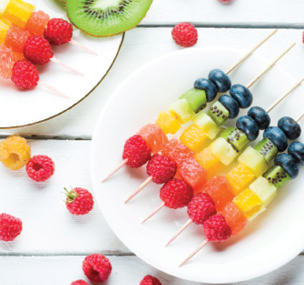
Rainbow fruit kabobs
Cut an assortment of fruits, such as pineapples, grapes, blueberries, raspberries, blackberries, grapefruit, strawberries, watermelon, apples, tangerines, honeydew, cantaloupe, kiwi and bananas. Arrange fruit on skewer sticks.

Make your own pizza
Pizza dough:
• 1 Tbs active dry yeast
• 1 cup warm water
• 2 1/2 cups all-purpose flour, plus some extra for rolling dough
• 1 tsp salt
• 1 tsp olive oil
You can also use any premade 12” pizza crust or pita bread as a crust substitute.
Toppings:
• 1/3 cup tomato sauce
• 2 cups shredded mozzarella or
Monterey Jack cheese
• 2 cups toppings of choice: bell peppers, zucchini, onion, mushrooms, olives, tomatoes, pepperoni, chicken, ham, basil, garlic, artichokes, etc.
Add yeast and water to a large mixing bowl. Stir once to activate yeast and let it sit for five minutes. Add flour, salt and olive oil. Mix until a dough is formed and knead on a floured surface for two minutes. Place in a greased bowl and turn to fully coat in oil. Cover and let it rise for 20 minutes. Preheat the oven to 400 degrees as you wait for the dough to rise. After 20 minutes, place the dough on a flat surface and roll into a 12” circle. Place on a 12” greased pizza pan. Spread tomato sauce evenly on the crust. Sprinkle cheese evenly on top of the tomato sauce. Add desired toppings. Bake for 20 minutes or until the cheese is bubbling or turning brown and the crust is starting to crisp.
Recipe adapted from Food.com
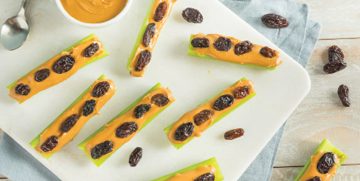
Ants on a log
• Celery stalks, cut into 3” pieces
• Spread: peanut butter (or other nut butter), Greek yogurt or hummus
• Toppings or “ants”: raisins, cranberries, blueberries, chocolate chips, black beans or diced peppers
Place desired spread along the cavity of the celery. Top it off with “ants” of choice. Press them into the spread.
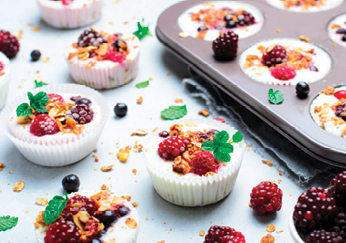
No-bake frozen yogurt berry granola treats
• 4 Tbs peanut butter
• 4 Tbs honey
• 2 cups granola
• 2 1/2 cups Greek yogurt,
any flavor
• 1/2 cup berries or dark chocolate chunks for garnish
• Mint for garnish, optional
Heat peanut butter and honey in the microwave for 30 seconds, or until melted. Pour into a medium sized bowl and stir to combine with granola. Divide mixture evenly into 12 lined muffin cups. Press firmly to the bottom. Top each cup with yogurt, divided evenly. Garnish with toppings of choice. Cover tightly with foil and freeze for at least two hours. Keep frozen and thaw for a few minutes before eating.
Recipe adapted from Tasty.com
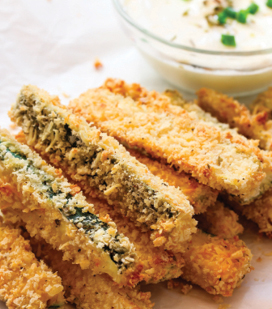
Zucchini fries
Fries:
• 2 zucchinis, cut into 3-inch pieces
• 1 cup panko breadcrumbs
• 1/2 cup grated Parmesan cheese
• 1 Tbs garlic powder
• 1 Tbs dried basil
• 1 tsp salt
• 1 tsp pepper
• 2 eggs
Dip:
• 1 cup plain Greek yogurt
• 1 Tbs lemon juice
• 2 Tbs fresh chives
• 1/4 tsp salt
• 1/4 tsp pepper
Preheat the oven to 425 degrees. Cut zucchini into 3-inch pieces. In a large bowl combine panko breadcrumbs, Parmesan, garlic powder, basil, salt and pepper. Whisk eggs in a shallow bowl. Dip zucchini in eggs, coating evenly, and then toss in bread crumb mixture. Place on a baking sheet lined with parchment paper. Bake for 15-20 minutes, flipping halfway. While fries are baking, combine all dip ingredients in a small bowl and set aside in the refrigerator. Dip and enjoy!
Recipe adapted from Tasty.com.
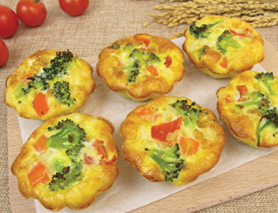
Mini egg frittatas
• 8 large eggs
• 1/2 cup whole milk
• 1/2 tsp black pepper
• 1/4 tsp salt
• 1/3 cup grated Parmesan cheese
• 1 cup fillings of choice: diced ham, mushrooms, broccoli, bell peppers, onions, spinach, olives, parsley, tomato, etc.
Preheat the oven to 375 degrees. Spray two mini muffin tins (each with 24 cups) with nonstick spray. Whisk eggs, milk, pepper and salt in a large bowl. Stir in cheese and desired fillings. Fill muffin cups about ¾ full with the egg mixture. This will allow some room for frittatas to puff up. Bake for 8-10 minutes or until the egg puffs up. Use a rubber spatula to loosen and remove the frittatas from the muffin cups.
Recipe adapted from Food Network.








